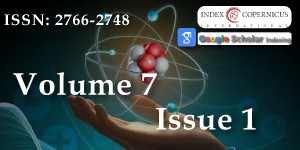Estimating the Minimum Possible Deceleration of Cosmic Expansion Post-inflation
Main Article Content
Abstract
The inflationary epoch, occurring shortly after the Big Bang, initiated an extraordinarily rapid exponential expansion of the universe. Following this period, the rate of cosmic expansion decelerated for approximately 9.8 billion years, until observations indicated a transition to an accelerated expansion of space-time. This paper aims to estimate the minimum possible deceleration of cosmic expansion during the post-inflationary epoch, addressing an unresolved aspect of cosmological studies. The observable universe is modeled as a spherical region defined by the particle horizon in the FLRW metric. The model operates on the principle that the speed of light cannot exceed the speed of space-time expansion, given that photons are bound by space-time constraints. This paper hypothesizes that at the end of the 9.8 billion years of deceleration, the expansion speed was at its lowest, nearly equating to the speed of light. Subsequently, this speed has increased, correlating with the current accelerated expansion. Through a graphical representation assuming a uniform rate of change in expansion speed (for minimum possible values), we apply concepts of onedimensional motion to derive our estimates. This novel approach provides a foundational calculation of the minimum deceleration, significantly contributing to the understanding of the dynamics of cosmic expansion and offering a basis for future research and observational refinement.
Article Details
Copyright (c) 2024 Sharma D.

This work is licensed under a Creative Commons Attribution 4.0 International License.
The International Journal of Physics Research and Applications is committed in making it easier for people to share and build upon the work of others while maintaining consistency with the rules of copyright. In order to use the Open Access paradigm to the maximum extent in true terms as free of charge online access along with usage right, we grant usage rights through the use of specific Creative Commons license.
License: Copyright © 2017 - 2025 |  Open Access by International Journal of Physics Research and Applications is licensed under a Creative Commons Attribution 4.0 International License. Based on a work at Heighten Science Publications Inc.
Open Access by International Journal of Physics Research and Applications is licensed under a Creative Commons Attribution 4.0 International License. Based on a work at Heighten Science Publications Inc.
With this license, the authors are allowed that after publishing with the journal, they can share their research by posting a free draft copy of their article to any repository or website.
Compliance 'CC BY' license helps in:
| Permission to read and download | ✓ |
| Permission to display in a repository | ✓ |
| Permission to translate | ✓ |
| Commercial uses of manuscript | ✓ |
'CC' stands for Creative Commons license. 'BY' symbolizes that users have provided attribution to the creator that the published manuscripts can be used or shared. This license allows for redistribution, commercial and non-commercial, as long as it is passed along unchanged and in whole, with credit to the author.
Please take in notification that Creative Commons user licenses are non-revocable. We recommend authors to check if their funding body requires a specific license.
Fraknoi A, Morrison D, Wolff S. Astronomy 2e ( hardcover, Full Color). Independently Published; 2023.
Gott JR 3rd, et al. A map of the universe. Astrophys J. 2005 May;624(2):463–484.
Aghanim N, Akrami Y, et al. Planck 2018 results: Vi. cosmological parameters. Astron Astrophys. 2020 Sep;641
Tanabashi M, Hagiwara K, et al. Review of particle physics. Phys Rev D. 2018 Aug;98(3):030001.
Ryden B. Introduction to Cosmology. Cambridge University Press; 2017.
NASA Hubble Mission Team. Nasa’s Hubble rules out one alternative to dark energy; 2011.
Stein V. What is the speed of light? 2023.
Mike and Tamara. Universe after inflation; 2007.
Perlmutter S, et al. Measurements of omega and lambda from 42 high-redshift supernovae. Astrophys J. 1999;517:565–586.
Riess AG, et al. Observational evidence from supernovae for an accelerating universe and a cosmological constant. Astron J. 1998;116:1009–1038.
Peebles PJE, Ratra B. The cosmological constant and dark energy. Rev Mod Phys. 2003;75(2):559–606.
Caldwell RR, Dave R, Steinhardt PJ. Cosmological imprint of an energy component with general equation of state. Phys Rev Lett. 1998;80(8):1582.
Copeland EJ, Sami M, Tsujikawa S. Dynamics of dark energy. Int J Mod Phys D. 2006;15(11):1753–1936.
Starobinsky AA. A new type of isotropic cosmological model without singularity. Phys Lett B. 1980;91(1):99–102.
Nojiri S, Odintsov SD. Introduction to modified gravity and gravitational alternative for dark energy. Int J Geom Methods Mod Phys. 2006;4(1):115–146.
Vlahovic B. Spherical shell cosmological model and uniformity of cosmic microwave background radiation. 2012 Jul.
Loeb A. Long-term future of extragalactic astronomy. Phys Rev D. 2002 Jan;65(4):047301.

